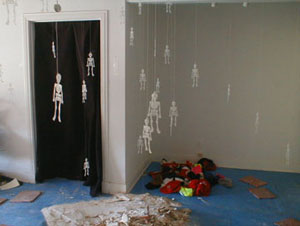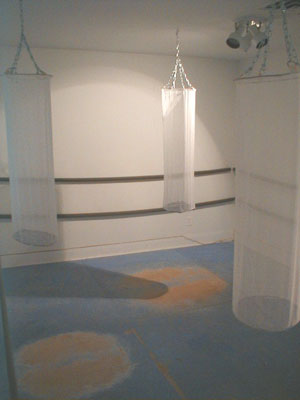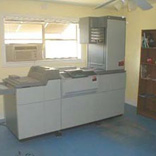Fun and chaotic as a barrelful of monkeys, Slumber House is a series of installations in a flood damaged building next door to the Poissant Gallery in the West End. The former house/office/restaurant is due for major renovation, making its interior expendable and allowing the ten artists in the show to do as they please with the walls, floors and fixtures. Inevitably crowded and inconsistent, the uniformly casual ambiance of the show goes a long way towards minimizing its flaws. You can hardly expect perfection in a water-damaged ruin.
At the entrance, Paul Horn’s delightfully anachronistic haunted room is more appropriate to Halloween than Christmas, creating a mini time warp from one holiday season to another. Tiny skeletons hanging from the ceiling unify disparate piles of junk, some indigenous (piles of damp crumbling plasterboard and insulation) some specially installed. Each junk node sports a few more intense aggregations that are Horn’s works. Trashy and unresolved (I mean this in a good way), Horn’s troubling juxtapositions are, like the show, hit and miss: moments of odd poetry, like the severed finger/ frosted pine-cone diorama, and grotesque stupidity (also good), like the light-up Frankenstein hand, alternate with more expectable bad-boy paintings. With Horn’s work, you’ve got to take the baby and the bathwater for the sake of those not infrequent nuggets of mad genius.
Justin Kidd’s office is amazingly thorough; amid the chaos and destruction of the other installations, Kidd’s room is comparatively clean, dominated by a Volkswagen-sized industrial copy machine. The machine is new, so big and so vastly incongruous that it creates a wholly new sense of place: neither ruined dwelling nor art-student project, one wonders whether or not Kidd’s room is part of the show at all. The room is also furnished with a desk, a bookshelf and several of Kidd’s cardboard machines. The best parts continue the office metaphor begun so forcefully by the copy machine. Each drawer of the desk holds typical clutter, with just enough art-relevant material to suggest it is indeed part of the piece. Pens, phone book, catalog of contemporary Dutch artists, and an extensive file of uncollated zine pages, (no doubt copied on the machine nearby) give the sense that Kidd was hard at work on a zine project a moment ago, and left to get coffee. Or perhaps more than a moment ago: an unobtrusive paper cobweb is pasted carefully under one leg of the desk.
Brushing aside the black curtain that screened Kelly Pike’s room, I was suddenly the main event in a phantom boxing match. In a neat reversal of roles, I switched from viewer to viewed, and expected someone to pop up and punch me. The piece is weakened by transparent punching bags and a pair of cast plaster boxing gloves which hint at a ghostly opponent., but the startling shift from expecting to look at something to being looked at is powerful.
Eric Pearce’s If You get Lucky…, at the back of the kitchen, is underplayed. Lots of pennies stuck to a black cloth to form a heavy, metallic curtain. It was better the next day, when some of the coins began to fall off at random, littering the floor.
ewel Baird Gleeson’s Pink Bathroom had the macabre silliness of a teen horror flick, but only on the opening night, when an unidentified actress lay hidden in the cabinet above the tub, dangling a leg out the door and making bumping thumping noises. In the dim candlelight, clots of hair and dark goo stained the (pink) towels and the sink, creating a scene of melodramatic mayhem in the best haunted house tradition.
All images are courtesy the artists and Poissant Gallery.
Bill Davenport is an artist and writer from Houston, whose quirky objects have appeared in many shows everywhere.







